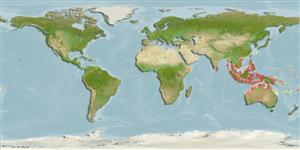Actinopterygii (ray-finned fishes) >
Perciformes (Perch-likes) >
Pempheridae (Sweepers)
Etymology: Pempheris: Greek, pempheris = the name of a fish (Ref. 45335). More on author: Cuvier.
Issue
Regarded as nomen dubium (unavailable) in Randall et al., 2014 (Ref. 95583:21)
Environment / Climate / Range
Ecology
Marine; brackish; reef-associated. Tropical, preferred ?
Indo-West Pacific: southwest Sumatra to Bali Strait, and Malaysia (Ref. 5756).
Size / Weight / Age
Maturity: Lm ? range ? - ? cm
Max length : 15.0 cm NG male/unsexed; (Ref. 27550)
Inhabits coral reefs and rocky areas (Ref. 27550). Enters estuaries (Ref. 27550). Feeds on crustaceans and polychaete worms (Ref. 27550).
Life cycle and mating behavior
Maturity | Reproduction | Spawning | Eggs | Fecundity | Larvae
Gloerfelt-Tarp, T. and P.J. Kailola, 1984. Trawled fishes of southern Indonesia and northwestern Australia. Australian Development Assistance Bureau, Australia, Directorate General of Fishes, Indonesia, and German Agency for Technical Cooperation, Federal Republic of Germany. 407 p. (Ref. 5978)
IUCN Red List Status (Ref. 115185)
CITES (Ref. 94142)
Not Evaluated
Threat to humans
Harmless
Human uses
More information
Common namesSynonymsMetabolismPredatorsEcotoxicologyReproductionMaturitySpawningFecundityEggsEgg development
Age/SizeGrowthLength-weightLength-lengthLength-frequenciesMorphometricsMorphologyLarvaeLarval dynamicsRecruitmentAbundance
ReferencesAquacultureAquaculture profileStrainsGeneticsAllele frequenciesHeritabilityDiseasesProcessingMass conversion
Tools
Special reports
Download XML
Internet sources
Estimates of some properties based on models
Phylogenetic diversity index (Ref.
82805): PD
50 = 0.5000 [Uniqueness, from 0.5 = low to 2.0 = high].
Bayesian length-weight: a=0.01622 (0.00688 - 0.03823), b=2.99 (2.78 - 3.20), in cm Total Length, based on LWR estimates for this (Sub)family-body shape (Ref.
93245).
Trophic Level (Ref.
69278): 3.3 ±0.38 se; Based on food items.
Resilience (Ref.
69278): High, minimum population doubling time less than 15 months (Preliminary K or Fecundity.).
Vulnerability (Ref.
59153): Low to moderate vulnerability (26 of 100) .
